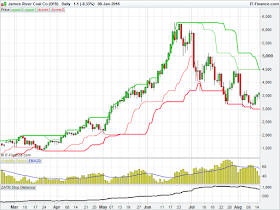What a start to 2016! The markets have certainly been 'interesting' to say the last, with the major market averages taking a bit of a hit.
As always, no-one knows what will happen over the coming weeks or months. All trend followers will do is follow price action.
One thing that people who trade individual stocks should look for, is decent set ups and signals given which seemingly are going against the general market - if you will excuse the pun, they are 'bucking the trend' of the market as a whole. These signals can often deliver wonderful results. What these stocks are doing is exhibiting a high level of relative strength or weakness compared to the market.
An example of relative strength would be getting a long signal on a stock during a general market downtrend. An example of relative weakness would be getting a short signal on a short during a general market uptrend.
Even if the indices are trending in one direction, there will always be individual stocks trending in the opposite direction. These stocks may well have specific issues surrounding them, but they are trending in spite of what the general markets are doing. Often, they will develop a character or mind of their own. And, as we know, trends have a habit of persisting until the trend ends.
This idea goes against the conventional thinking that you solely trade in the direction of the market - the 'top down' theory.
When you do get into a stock that starts to trend nicely in your favour, then as long as price is still acting right, then you should not get frightened out of that position - even if the markets are going in the opposite direction.
You are trading that individual stock, not the index. Therefore, you should concentrate solely on the price action on the stock you are trading.
Below is the chart of a stock one of the guys in our group is currently holding. As you can see, this is a beautiful, stable uptrend, ignoring what is going on elsewhere.
It would be so easy for an inexperienced trader to get scared out of his position, for fear of losing those profits, because of what has been happening in the general market. But no, this guy has worked on his mindset to ensure he has the patience and discipline to follow his rules, and is benefiting accordingly.
This is something that can only be learned over time. This particular trader has gone through this process, and I talked about his development in detail here.
I spoke to him the other night, and even now he still sees himself as a student, constantly learning, which is the ideal attitude to have.
This idea of getting into trades that are 'bucking the trend' really hit home to me in 2008. As we know, there was a major market downtrend that year, and most of my profits were made trading on the short side. However, the chart below shows one of the long trades I took, which then generated into a major winner.
Again, there was no need to exit the trade as price was acting right until the trailing stop was hit. It was simply a question of being able to follow the rules, and stay with the trend until the exit signal was given.



Regarding the Finnair trade, it would be interesting to know when our guy entered that trade. If he entered at some point that is not in the chart (too far away in the past, before mid July), he would have been got out of the trade around Aug 20-26. If he entered at the breakout around Aug 10, again, his trade would be closed on Aug 20-26. If he entered at one of the breakouts after Oct, there wasn't a low vol environment. So, the most important question of trading can be raised here, too: is he just lucky that he is long Finnair today? (my comment is based on the assumption that this guy is trading based on your methodology, the way I understood your methodology)
ReplyDeleteGood point. He trades two systems - one being the standard system as I trade it, the other being longer term - if you like he has his own version of the Turtles S1 and S2. The chart above shows the chart based on my own entry/exit parameters. He entered the trade in October on a breakout based on his own longer-term parameters, which met all his criteria. As it happens, the entry level he used wasn't too dissimilar to those indicated above.
ReplyDeleteSecondly, I'm pretty sure that most traders I know 'personalise' their own approach. They may take someone's rules and tweak them based on their own beliefs. Even amongst the traders I know, they have made changes to the rules that I use, adding new rules or taking bits out. Some use the same basic parameters, but only take end of day entry signals, whereas I use intra-day signals.
I don't think the Finnair trade is lucky. He followed his criteria, got the signal and entered the trade. What happens after that is out of his (or any traders) control. The market has to do its own thing. The breakout could easily have failed the day after entering. But that can happen with any trade. There's no such thing as a 'sure-fire' trade.
The point of the blog post was two-fold:
1) To keep your eyes open to potential trading opportunities which may be contra to the general market direction;
2) To reinforce the point that, once you do get into a trade that is trending, then you keep in that trade until your trailing exit level is hit - regardless of what other stocks or indices may be doing.
Hope this clarifies.